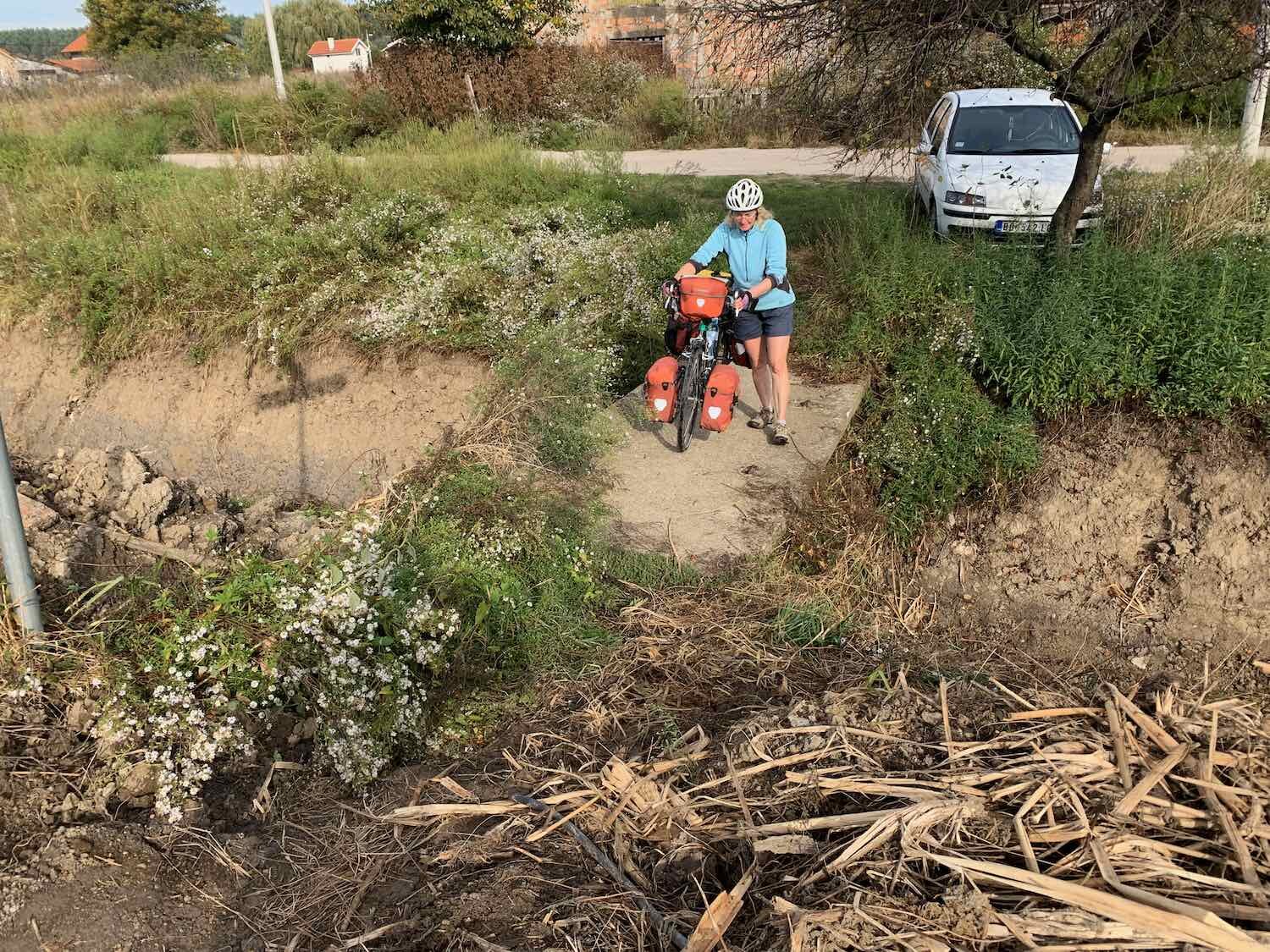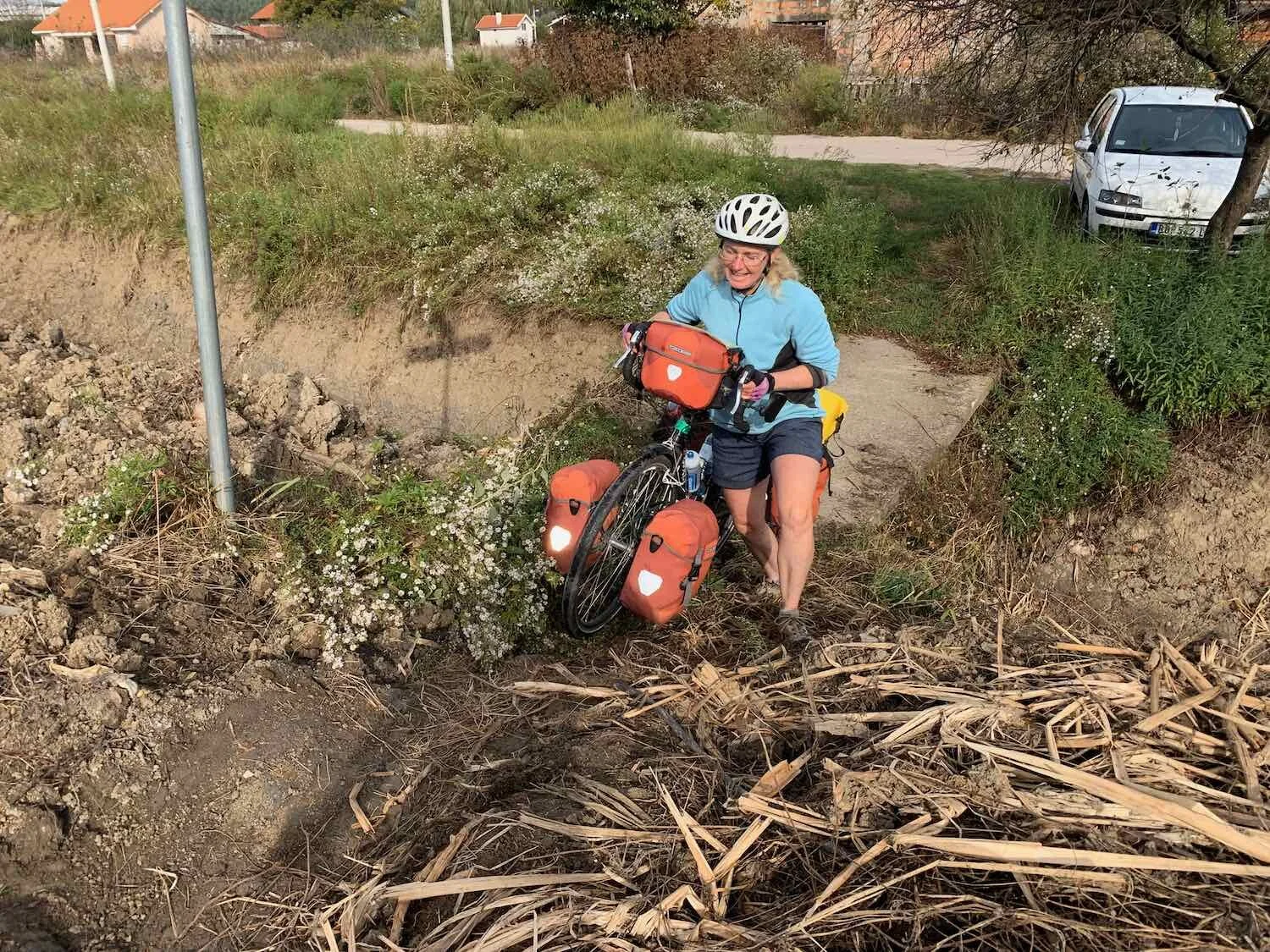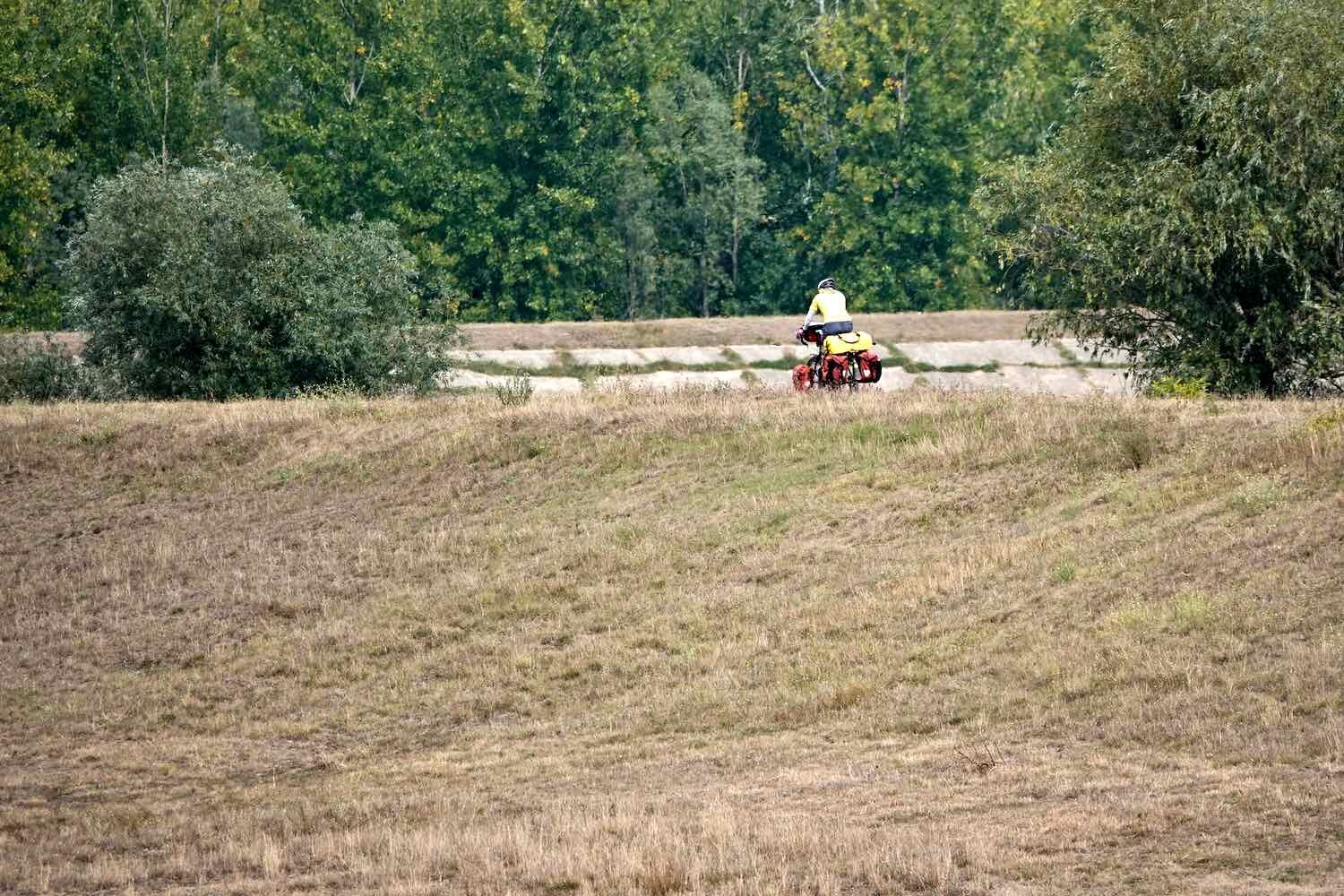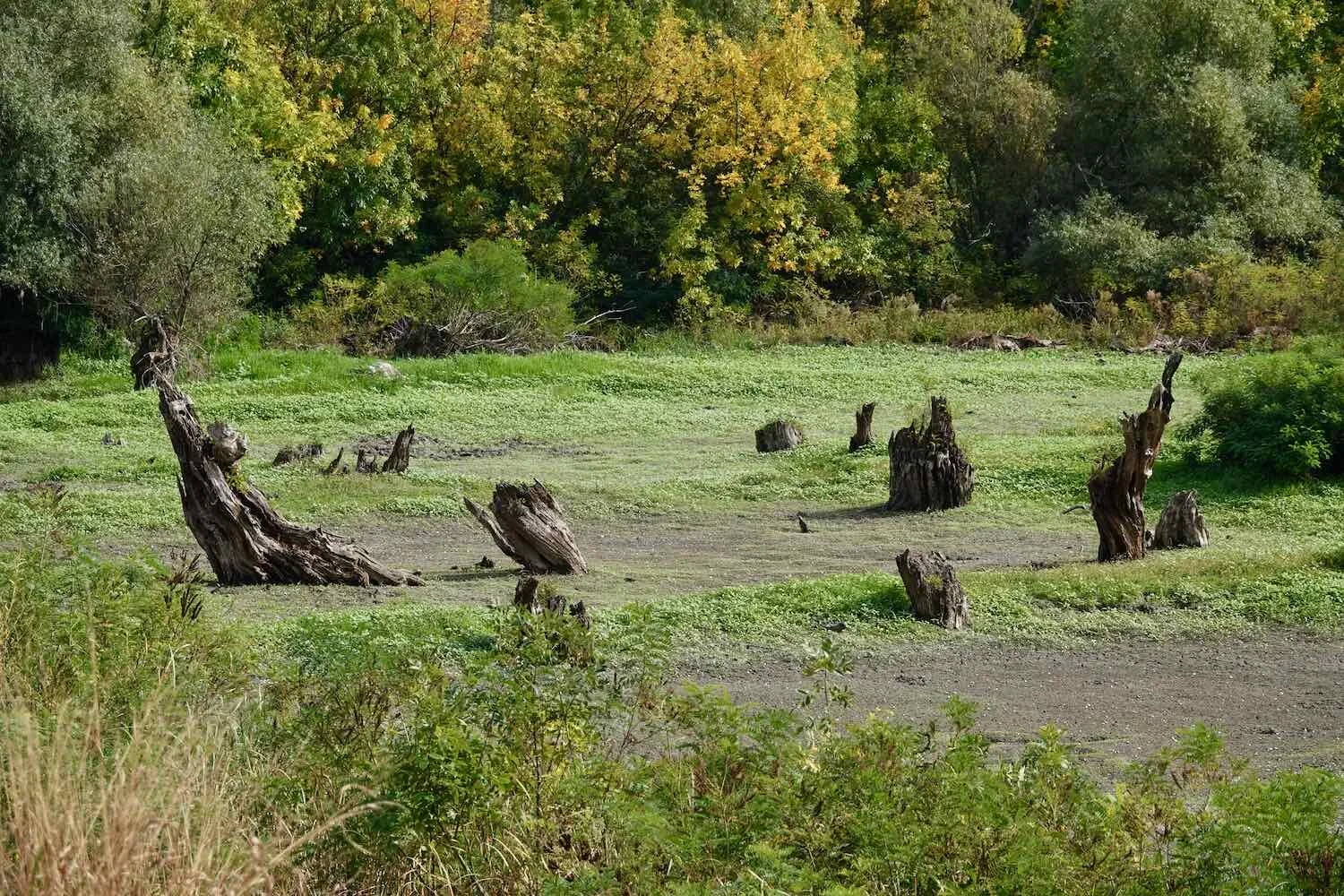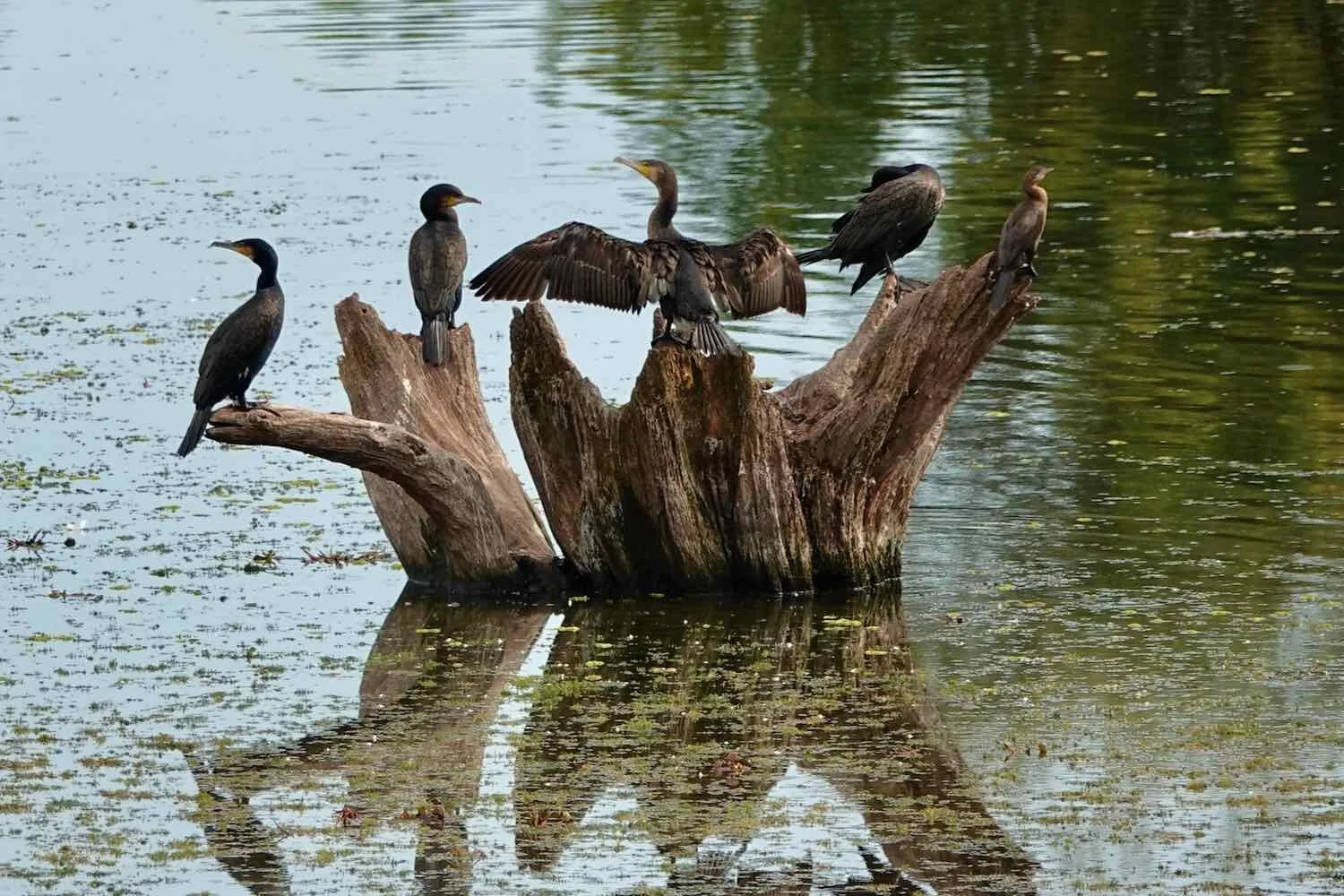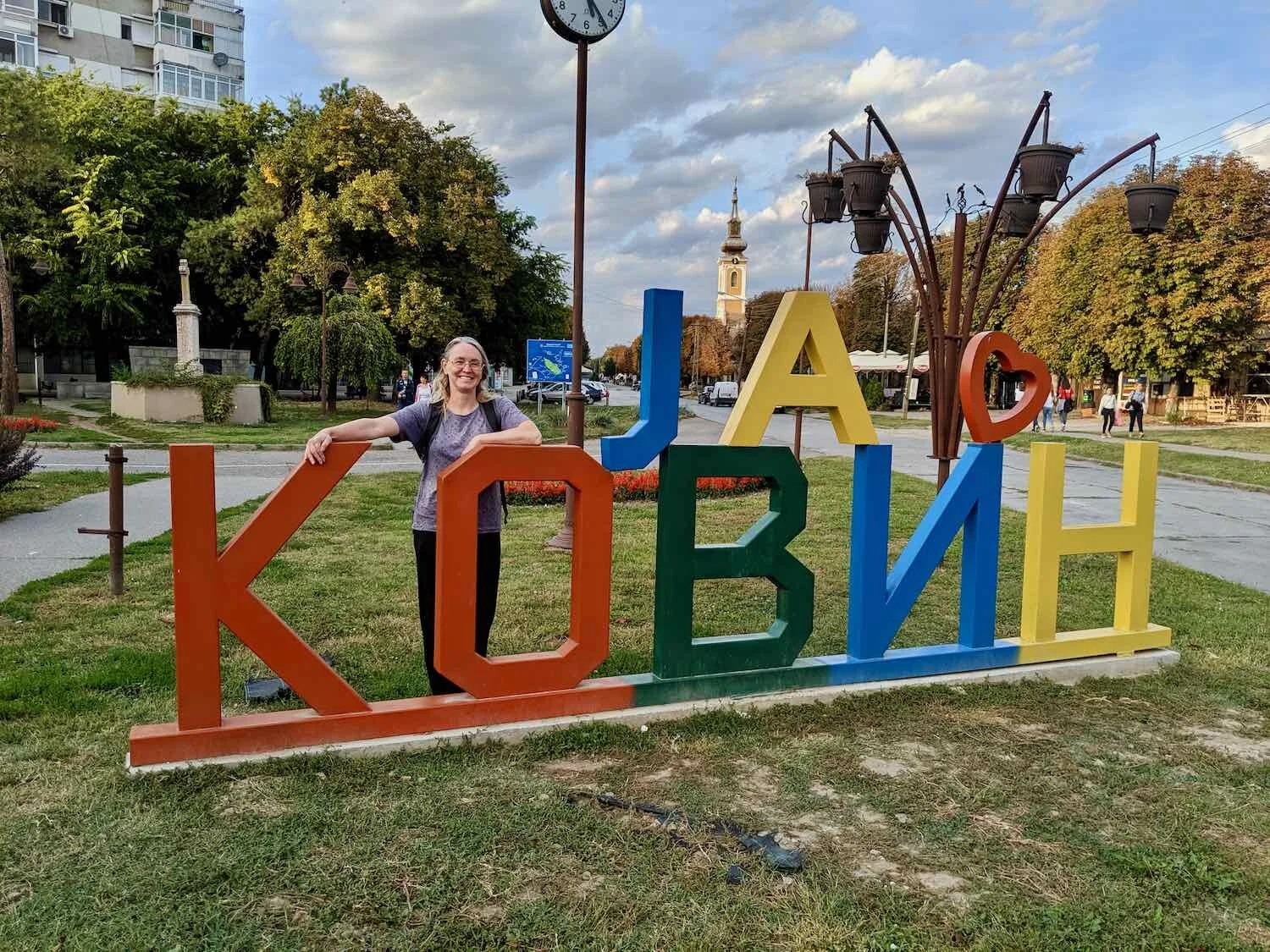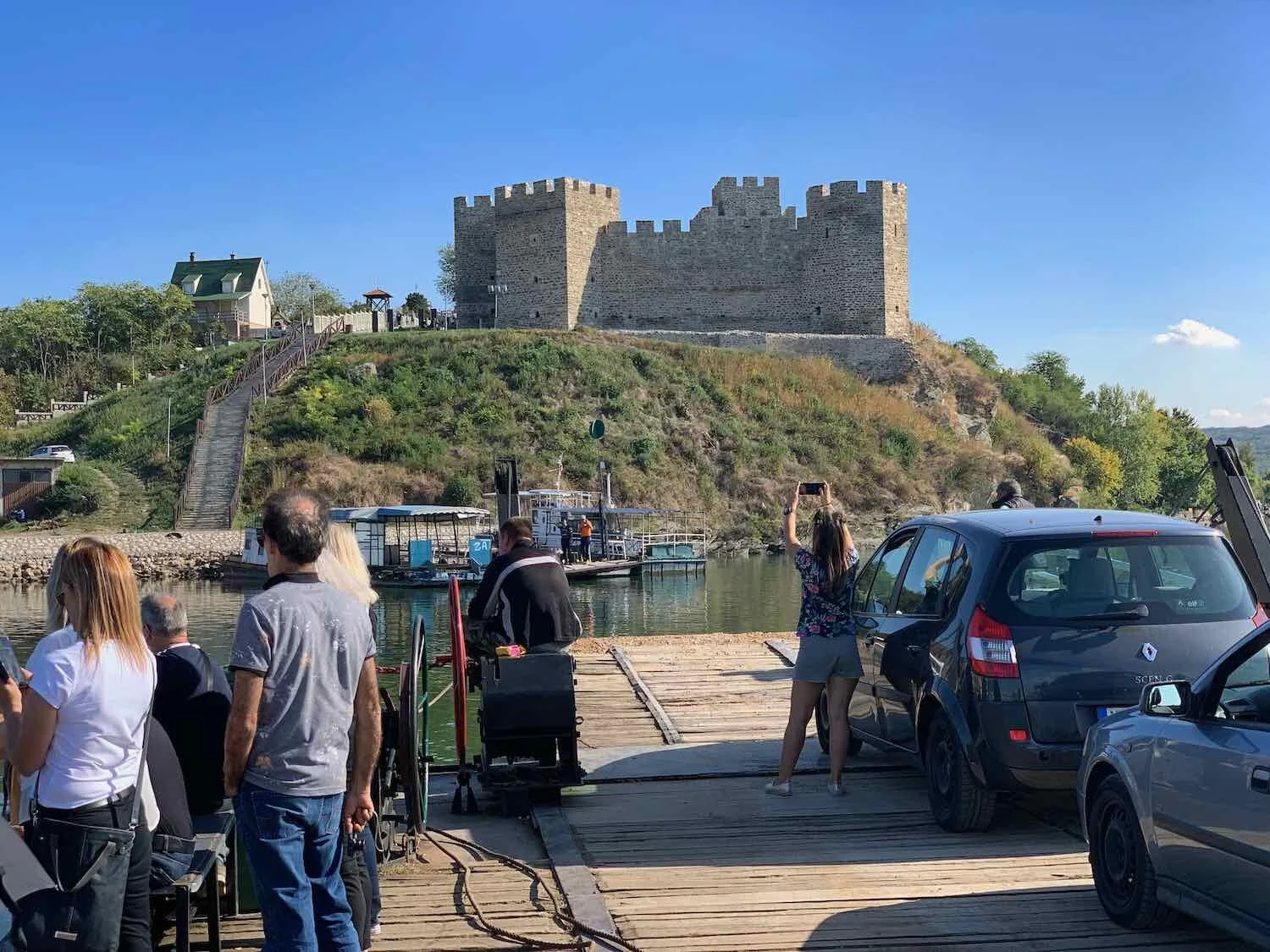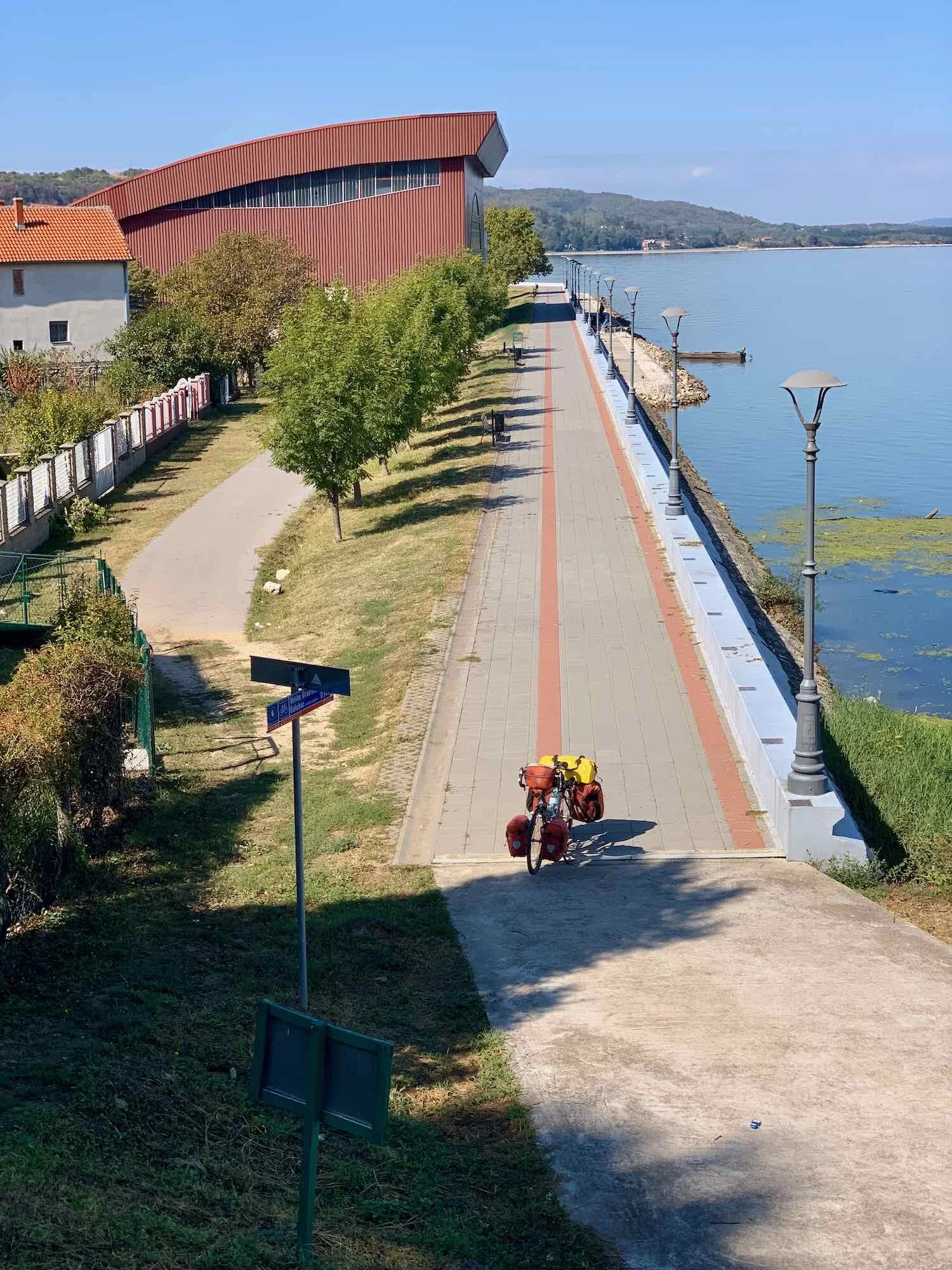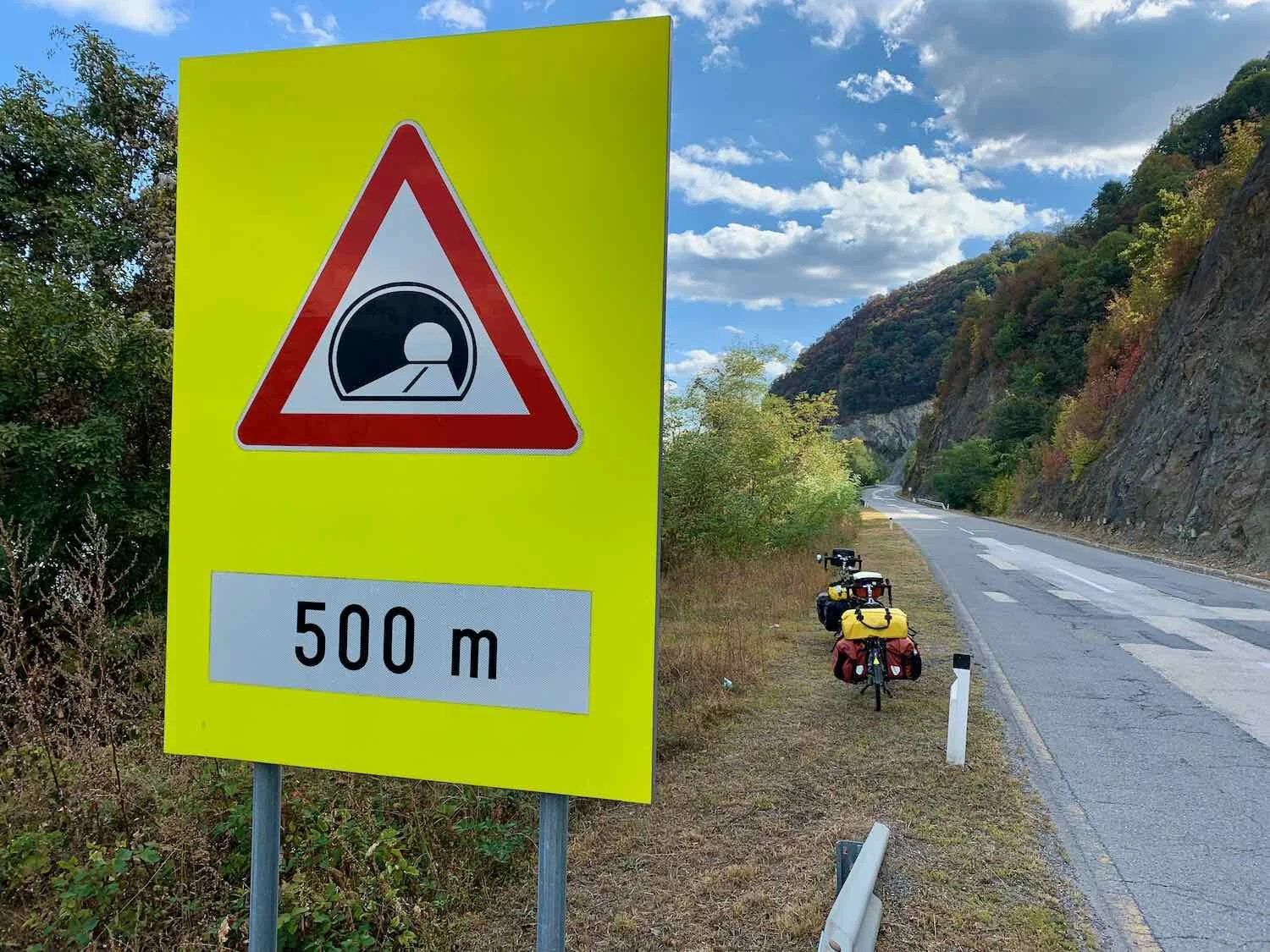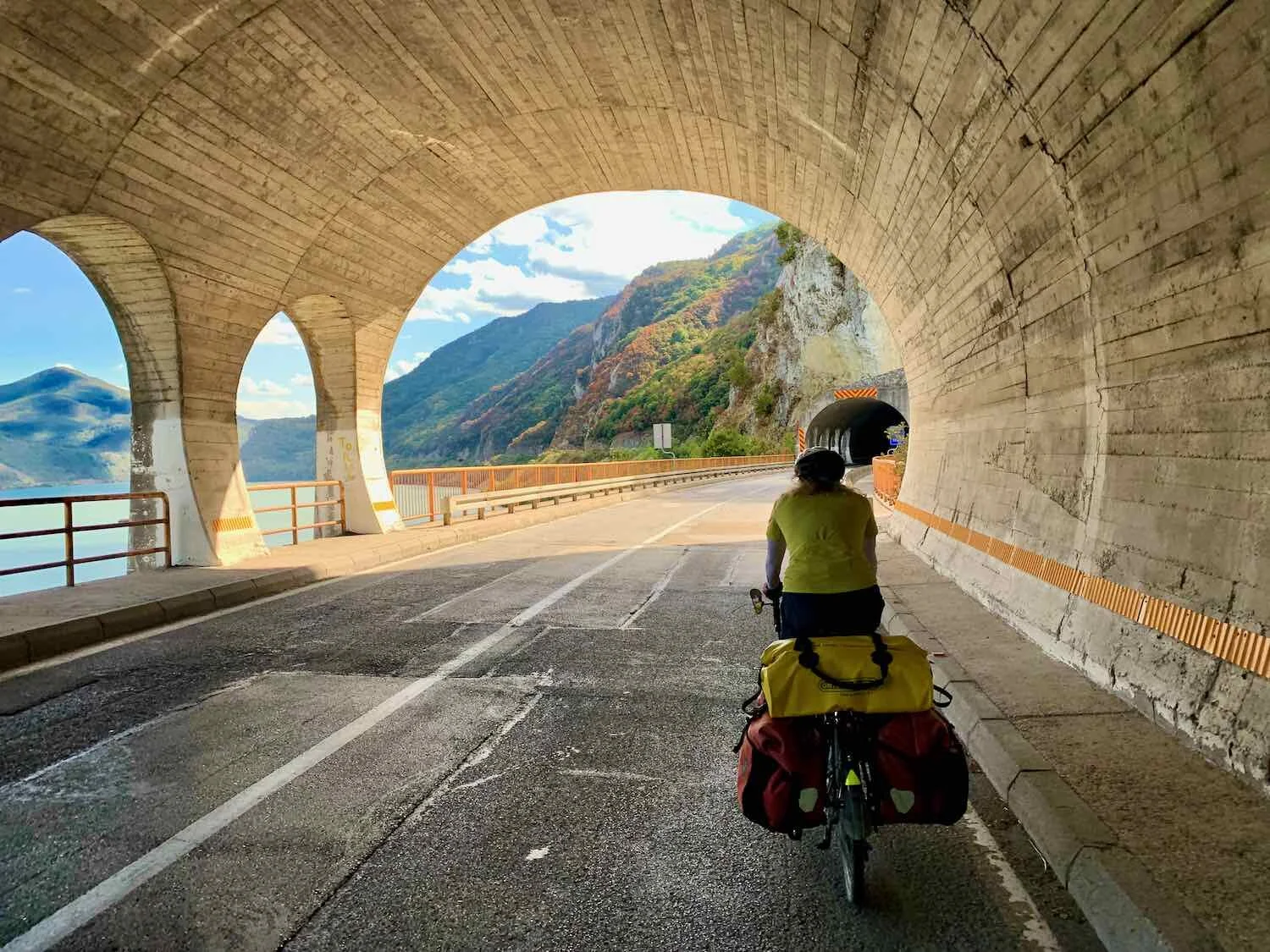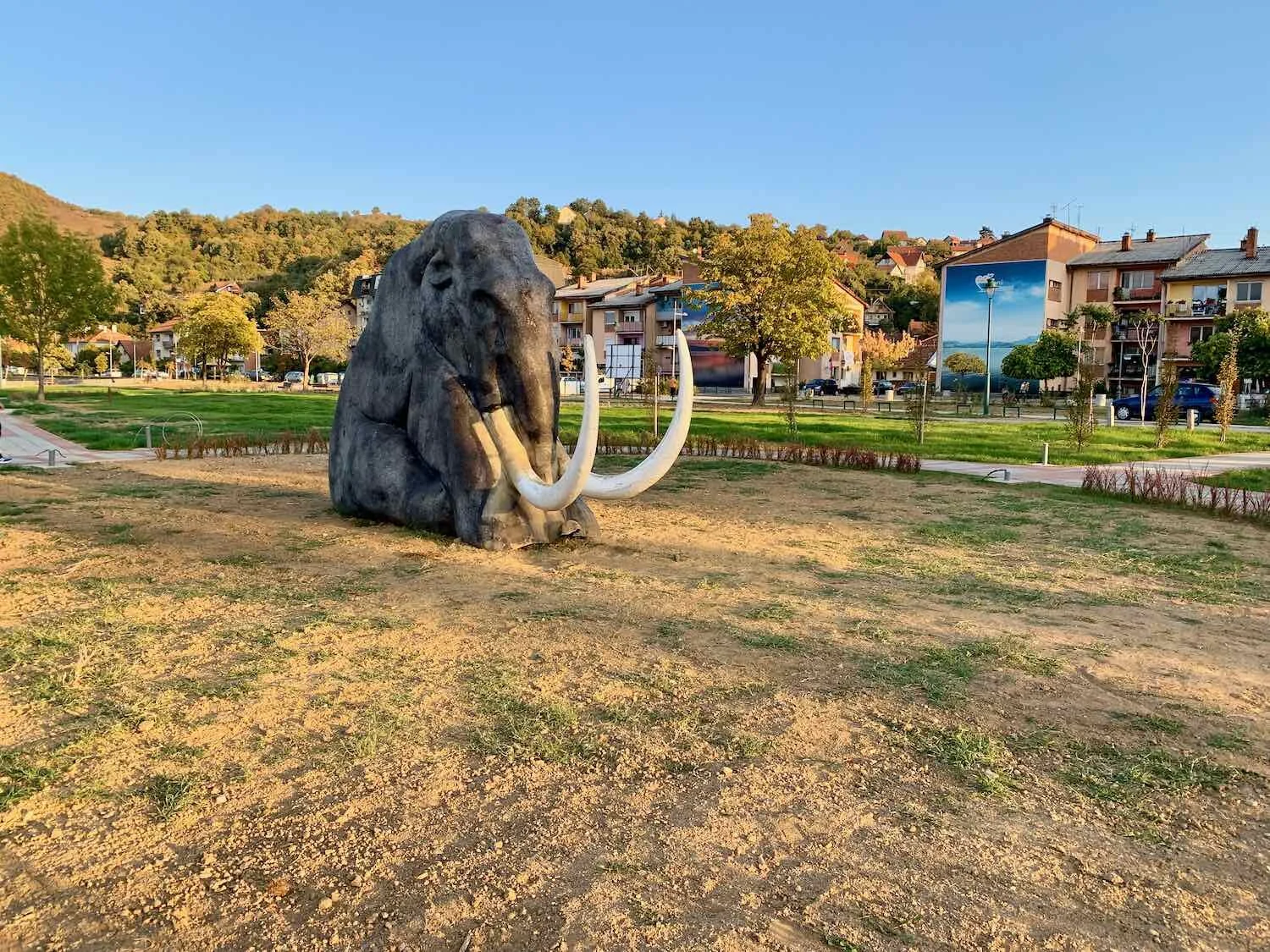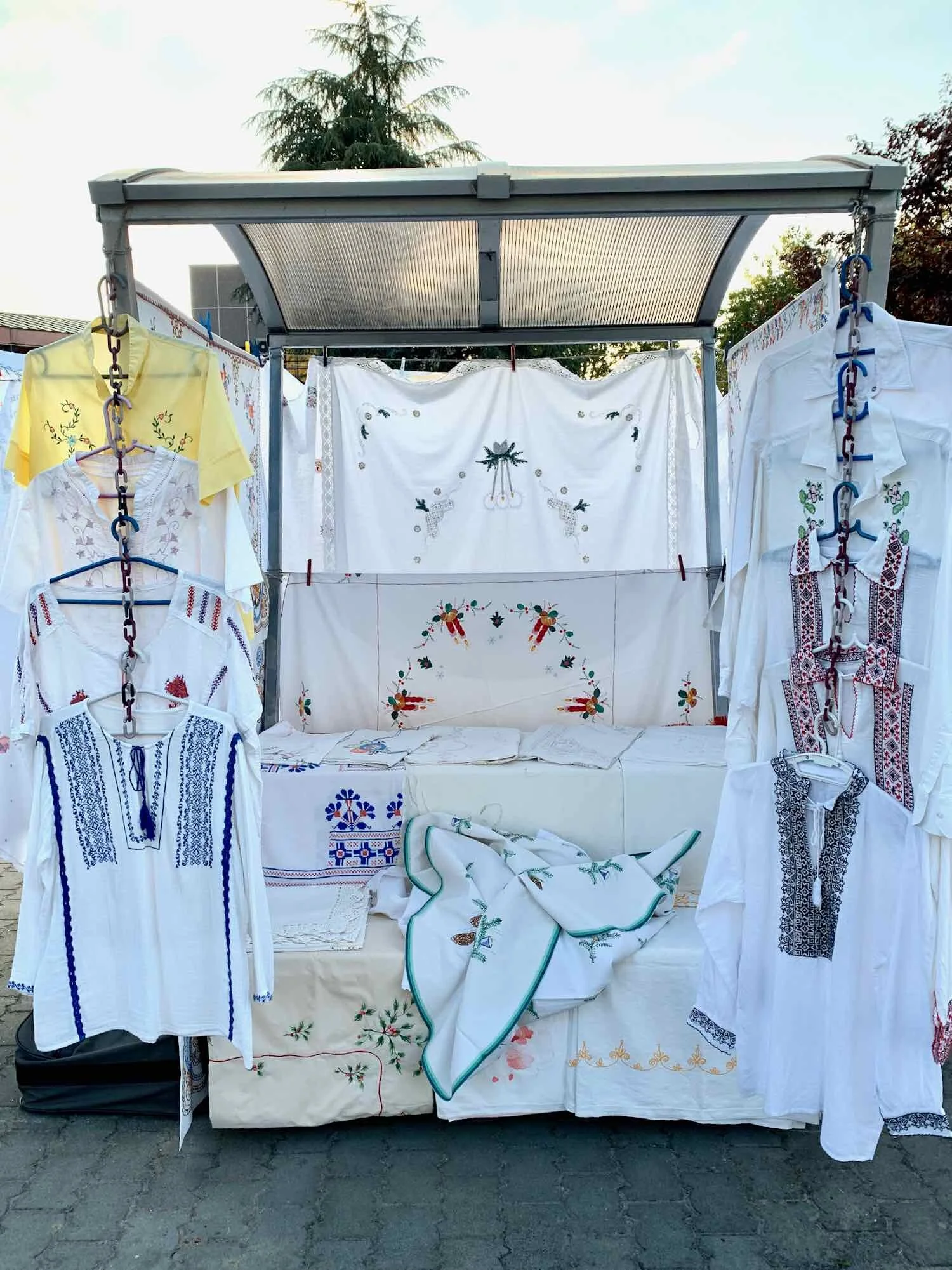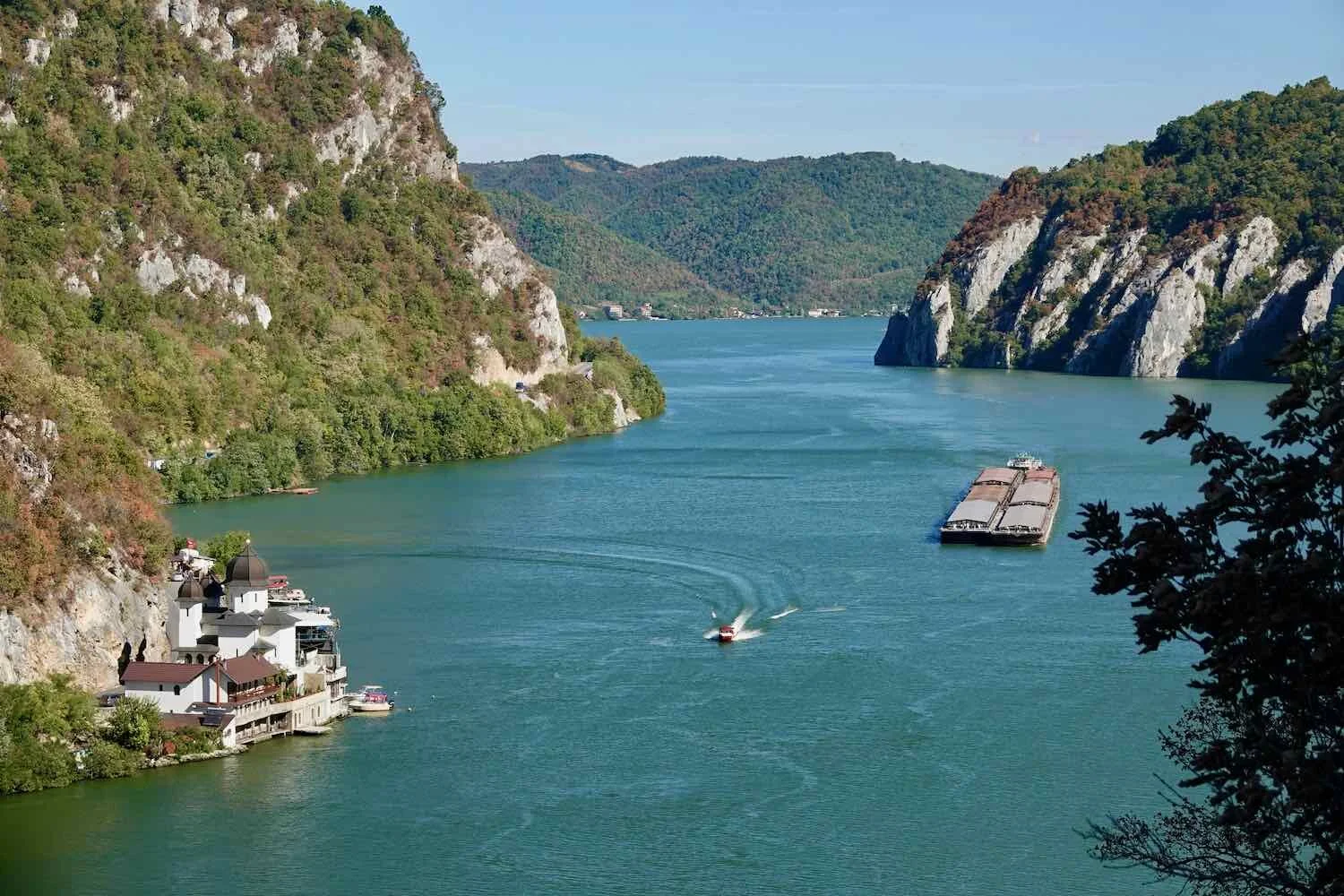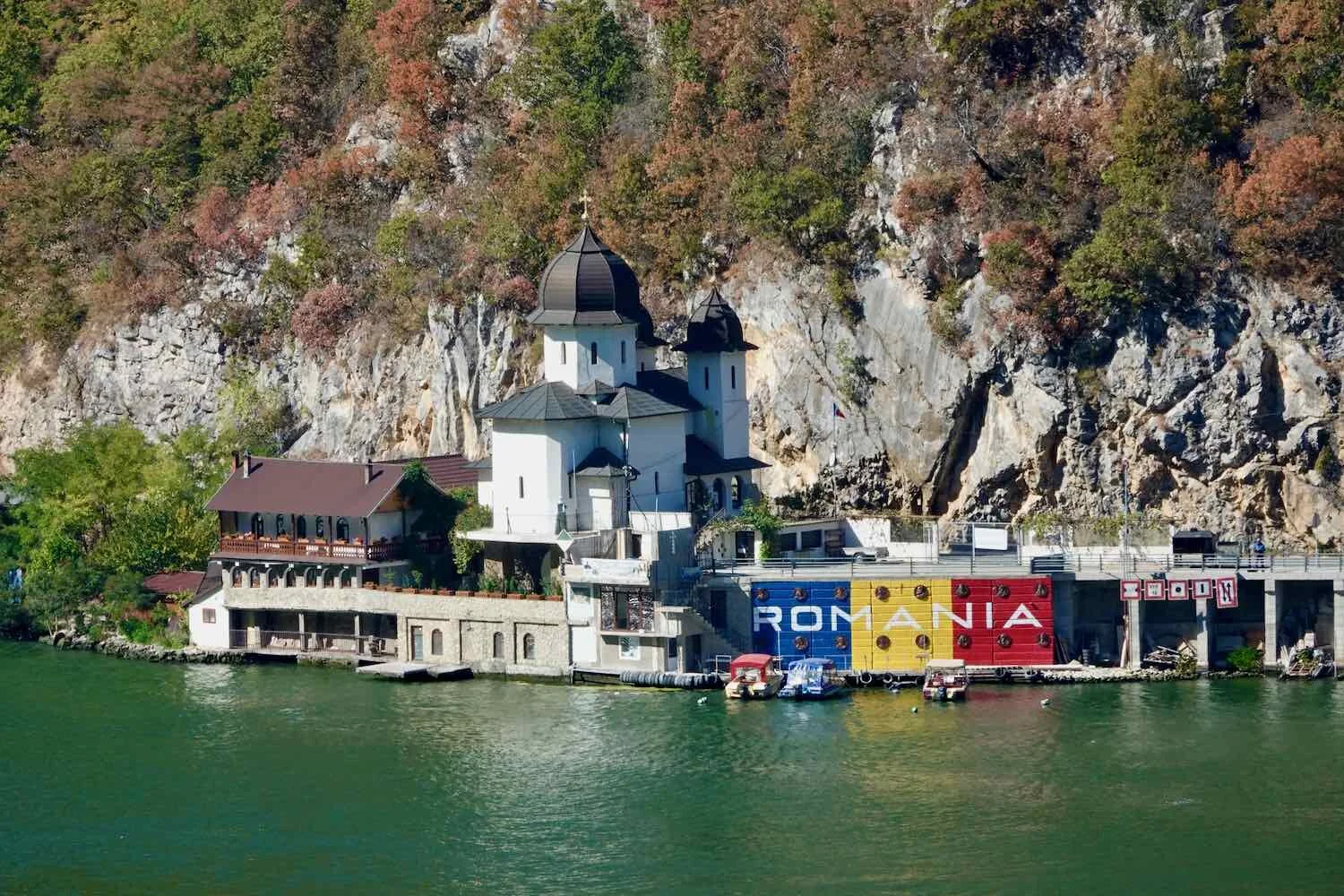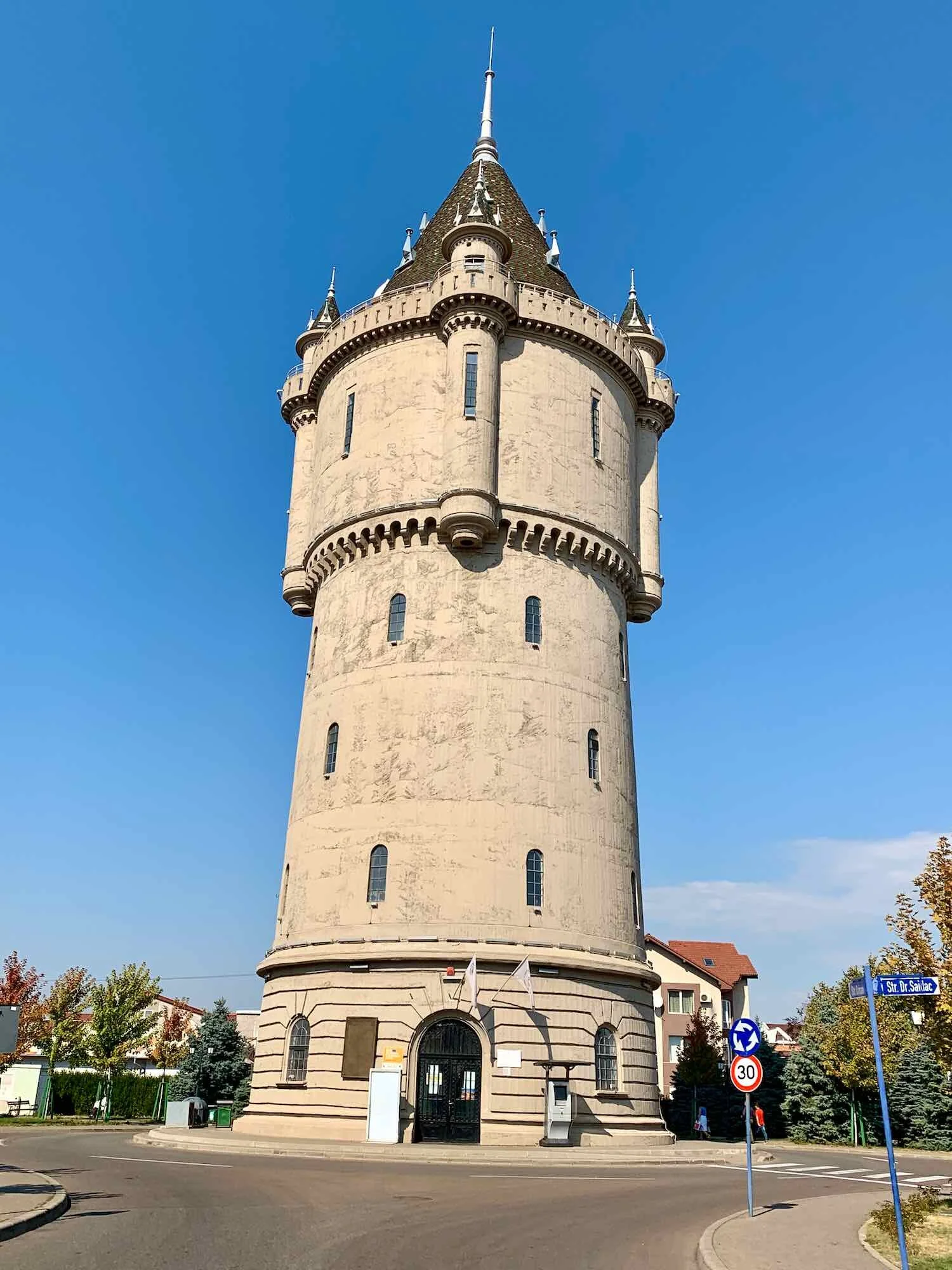Belgrade, Serbia to Drobeta-Turnu Severin, Romania: Cycling Through the Iron Gates
28 September - 2 October 2019
Belgrade to Kovin (28 September 2019, 74.0 km, 46 mi)
It was a beautiful morning when we set off from Belgrade. The rain of the past few days had ended, the sun was shining, and the winds were light. We breezed along, heading northwest out of the city center so that we could stay on the pedestrian-only streets as long as possible. When we hit the EuroVelo 6 route, we just kept going.
But wait… why was the Daube on our right side, and the sun behind us? I had a sinking feeling. We stopped to check a map, and sure enough, we were headed the wrong way (west) on the route. Darn. Right out of the gate we had added a couple of kilometers to the day’s ride.
Part of the reason it had been so easy to go astray was that by heading westward, we were riding along a very rare bike path. Because bike paths are so uncommon in this area, they lure you into thinking you are going the correct direction. A bike route obviously should follow one of the few bike paths in the area, correct? Wrong. Sometimes things just aren’t as logical as they should be.
So, we turned around and headed back east, towards the Pancevo Bridge. Our guidebook for the Danube Cycleway refers to the approach of the bridge as being “rough.” We can confirm that the condition of the route as you get close to the bridge becomes pretty sketchy, with lots of cracks, broken concrete, and debris that looks like it will put holes in your tires. We checked our map another couple of times to be sure we were really on the right route (we were). Fortunately, it’s possible to cross the bridge on a narrow, concrete shoulder that keeps you out of the traffic. And that was very welcome, because the bridge was incredibly busy. It’s one of only two bridges in the area - and the only one directly connecting Belgrade to the northern side of the Danube. So it’s packed with cars pretty much all the time.
Once we reached the far side of the river, we hit another snag. Our map didn’t match the route marked by the trail signs for EuroVelo 6. We stopped to examine the map and consider our options, when a couple of guys pulled up in a truck hoping to help us find the trail. They were convinced that we should go a third way, that was different from either our map or the signage. We were skeptical, but they were so insistent that we finally decided to follow their advice.
That turned out to be a bad idea. First we passed a medium sized dog that seemed calm, but then it went crazy after I passed - snarling and lunging at my back tire. Not good. When we turned up another road to try to get back to the trail, 4-5 aggressive, barking dogs that were hanging out by a pile of trash approached. We decided not to go that way.
In the end, we had to take a fairly long detour to get back onto the EuroVelo 6 route. And as a final bit of fun, we clambered up an overgrown embankment to reach the the trail.
We were thrilled to discover that, by this point, the route was back on the levee that borders the Danube River. We were ready for some nice, quiet trail riding - and that’s what we got. Our spirits improved dramatically once we were cruising along the crest of the levee. Potholes and puddles? No problem. Gravel and grass? Bring it on! We thoroughly enjoyed the peace and quiet, away from traffic and unfriendly dogs.
For the rest of the day, long stretches of the route were on unpaved levees, passing through natural areas like the Ivanovaka Ada Nature Park. There was just one short stretch, from Pancevo to Omoljica, where we were back on the road.
Peace and quiet, on the Danube levee. EuroVelo 6, Serbia. Copyright © 2018-2019 Pedals and Puffins.
At first we rode past this sign. But we wisely returned to read it, and heed it’s advice. Fortunately, the route through the town of Pancevo (where we saw this sign) was mostly on a paved bike path, separated from the cars. Pancevo, Serba. Copyright © 2018-2019 Pedals and Puffins.
The recent rains seem to have brought out the frogs in Biblical numbers. Every small puddle along the levee (and the big ones, too) had a crowd of Marsh Frogs that would go hopping off as we approached. They were excellent jumpers, springing high into the air like missiles being launched out of the little pools. Unfortunately, they would have been better off staying in the puddles. By jumping out, they put themselves in greater danger of being hit by a bike. We did a fair amount of swerving and weaving to try and avoid running over the little guys. Some bigger puddles had more than a dozen frogs. We saw hundreds of them along the trail.
Just one of the hundreds of Marsh Frogs that were out and about on the Danube levee, following a couple of days of rain. EuroVelo 6, Serbia. Copyright © 2018-2019 Pedals and Puffins.
On our right-hand side, between the levee and the Danube River, there were lots of flooded swamps and oxbow lakes. Most of the ponds were dotted with the decaying stumps of very large, old trees. It looked like the swampy areas had been created by man-made dikes, and the stumps were remnants of the forest that existed before the land was flooded. A variety of birds were perched on the old skeletons of the trees. We saw unusually high numbers of egrets, herons, cormorants, and ducks.
We’re also starting to see some of the first signs of fall. Down by the water, the leaves on a few of the trees are starting to turn yellow.
We arrived in Kovin (pop. 13,500) with enough time to walk into town before dinner. The downtown area was fairly big, with lots of small shops and cafes lining the main road. There were also a couple of fresh popcorn stands around the town’s main square. Popcorn street vendors were something we saw in Belgrade as well, but hadn’t seen anywhere else in Europe. We were especially happy to discover that the main supermarket was pretty big, and we were able to stock up on some items we could take with us on the road.
Welcome to Kovin, Serbia. Copyright © 2018-2019 Pedals and Puffins.
Kovin to Silver Lake (29 September 2019, 63.0 km, 39.1 mi)
As we were getting ready to leave in the morning, PedalingGuy realized his water bottle had started to get moldy inside. Eeew. He didn’t want to drink out of it anymore. So we headed back to the supermarket to try to buy a squeezable bottle of water that would fit in his bottle holder. The supermarket was supposed to be open, but it just wasn’t our lucky day. They were closed for inventory. Drat. Locals couldn’t believe they were closed either. While we were there, several people came by and pounded on the door, expecting someone to open the store. Then they’d throw up their arms in frustration when they realized the supermarket wasn’t going to open. Fortunately, a tiny store on the way out of town had the bottles we were looking for. But with all the messing around, it was pretty late by the time we got rolling.
Out on the levees, we were once again traveling on very rough tracks. It was slow going.
This morning we saw more cows than people out on the levees. Juzno-Banatski, Serbia. Copyright © 2018-2019 Pedals and Puffins.
Then, about 17 km into the ride, PedalingGuy got another flat tire. Ugh. We had both been worried about the impact of all the rough riding on our well-worn tires, and one finally gave out. We set up our camp chairs, and settled in to change the tire. Finding the hole was not too hard, and I was able to patch the tube. But then disaster struck. A gasket inside the pressure tube for our tire pump slid out of place, and jammed up the pumping mechanism. It was completely frozen - even with extreme effort, we couldn’t move the piston either up or down.
We took the pump apart, and it was pretty clear we wouldn’t be able to fix it. It’s toast. Unfortunately, we had not yet pumped up PedalingGuy’s front tire. Not the best thing to have happen where we were in Serbia, a long way from any towns.
Since our pump had been showing some wear and tear, and was no longer inspiring complete confidence when we started our trip back in February, we had been carrying a couple of pressurized air canisters for just such an occasion. PedalingGuy used one to inflate his tire. However, the canister didn’t get the tire fully inflated, so we will have to add more air as soon as we can. On top of that, we definitely need to get a new pump asap since the air canisters are only good for a single use. Sadly, we are pretty far away from any bike shops. Once you get past Belgrade going east, bike shops become almost nonexistent. Fortunately, around here auto shops and hardware stores will sometimes have a few bike parts and supplies. Hopefully we’ll be able to track down a pump in one of the towns we will pass through tomorrow.
This tire pump is toast. Luckily we had a backup canister of pressurized air that helped us inflate the flat tire, and get back on the road. Juzno-Banatski, Serbia. Copyright © 2018-2019 Pedals and Puffins.
By now we were pretty far behind schedule. We had only gone 20 km by noon. Adding to the pressure, we really needed to make it to 40 km by 2:30, because we had a ferry to catch. The ferry from Stara Palanka to Ram only runs once every three hours, so missing the next ferry would mean we’d end up cycling the end of the day in the dark. I started to sweat about that, too.
Then our luck turned. At about 25 km, we were back on asphalt, almost all the way to the ferry. Our speed on asphalt can be two-to-three times as fast as the dirt or grass trails. We flew along, and arrived at the ferry dock around 1pm.
Romania’s not far away. Just to the east of Stara Palanka on the north side of the Danube, is the Romanian border with Serbia. But we’re not headed that way. Our route takes us to the south side of the river via the ferry, to stay in Serbia for a couple more days.
There weren’t any great places to sit and wait. Most folks hang out at an outdoor cafe near the ferry landing. But when we tried to bring our bikes onto the patio of the cafe, the waiter told us we’d have to park them outside, where we wouldn’t be able to keep an eye on them. That wouldn’t do. So we headed back up the road until we found a shady spot near an apple orchard, and ate peanut butter and jelly for lunch, again.
The ferry was a hoot. It’s a small barge, pushed across the Danube by a tugboat. When it pulled up to shore, we were amazed to see it carrying two, double-long trailer trucks in addition to a handful of cars. The trucks barely fit. One of them was parked with a bend between the two trailers, because it was too long for the boat when stretched out, straight.
Big trucks on a little ferry. Stara Palanka, Serbia. Copyright © 2018-2019 Pedals and Puffins.
The docking process was rudimentary, too. There wasn’t a proper dock. Instead, the ferry just pulled up to a gravel embankment on the river’s edge. As the ferry approached, the crew lowered the gangway, and let it ram into the gravel bank. Then the two guys jumped off the boat, and used shovels to smooth out the ridge of gravel that formed where the boat hit the shore. All that had to happen before the vehicles could exit the ferry.
But the crew knew what they were doing, and pretty soon all the vehicles had been offloaded, and we were on board. The ferry ride across the Danube was lovely. Winds were very light, and the water was calm. The surrounding hills were quite scenic, covered in a mosaic of trees and grasslands.
Admiring the scenery from the Stara Palanka-to-Ram ferry. Juzno-Banatski, Serbia. Copyright © 2018-2019 Pedals and Puffins.
Once we arrived on the south side of the river, we had a choice of taking the main route, on an unpaved track along the river, or a paved alternative. We decided to stick with the route along the river. A key driver was the fact that we have been enjoying the off-road sections of the route much more than the on-road sections lately. In addition, the trail along the river was the way that the map on our phone followed, so it would be easier to navigate. But it turned out to be very different than we expected.
Almost immediately, the gravel trail surface got very rough. It was full of big stones. And there were weeds and underbrush encroaching on the trail, scratching at us, and causing us to have to shift back and forth across from one side of the trail to the other. On top of that, the profile of the trail had changed from flat to an endless series of short-but-steep and strenuous hills.
Our progress was incredibly slow. But then the route threw us for another loop, and the surface turned to sand. Sand is tough to ride through on a loaded bike. You seem to always be on the verge of losing control, or barely able to maintain forward momentum. Some of the sand was quite deep. At first we were able to pedal through. But soon enough we were pushing our bikes up sandy slopes. It was very Portuguese (i.e., we saw lots of this back in Portugal). And it was very tiring, especially coming so late in the day.
We later learned that this sandy area is on the fringes of two European deserts: the Deliblato Sands of Serbia (to the north), and the Oltenian Sahara (to the east). The Oltenian Sahara is particularly interesting because it’s Europe’s biggest desert - and also its newest. The area wasn’t a desert until it was extensively logged in the 1960s. The pine forests were unable to regenerate, leaving behind a sandy, barren landscape. The government is now trying to halt the growth of the desert through a focused tree-planting program.
We stopped to read a sign along the trail, and were approached by a group of women out for a hike. They were the only folks besides a few fishermen that we had seen along the trail since leaving the ferry. Several of them were English expats, living in Serbia. The other two were Romanian and Serbian. They were really friendly and we enjoyed talking with them about their hike, and the unusual, sandy landscape.
Stopping for a chat with some hikers along the trail. Branicevski, Serbia. Copyright © 2018-2019 Pedals and Puffins.
After about 9 km of very tough going, we finally made it back to pavement. We picked up the pace again, but by now it was very late in the day.
We saw several, large stacks of beehives along the road. Serbians and Romanians are both very fond of honey. Branicevski, Serbia. Copyright © 2018-2019 Pedals and Puffins.
By the time we arrived in the resort town of Silver Lake it was already 5pm (and sunset was 6:30). We had another 16 km to go to reach our original destination, which could easily take us two more hours. And by now we were pretty tired. We pulled over to the side of the road to weigh the pros and cons of continuing our ride, or stopping for the night.
While we were considering our options, a car pulled up next to us. It was the group of hikers we had met out on the trail. They invited us to have a drink with them at a bar on the river. But we hadn’t yet decided yet whether or not we would stop for the night, so we declined. It was too bad. Under less complicated circumstances, it would have been fun to get to know them better.
But after thinking it over, we decided to get a room at a hotel in Silver Lake. We’ll just ride 16 km farther tomorrow. The route should be less difficult, because there will be much less off-road riding.
Later in the evening we learned that the Serbian national volleyball team had just won the European championship. The hotel staff were particularly thrilled because the coach of the Serbian volleyball team is also the owner of the Vila Lago Hotel where we were staying. They had been watching the matches on TV in the lobby, and we could hear their cheers throughout most of the evening. It was fun to share in their excitement.
Silver Lake to Donji Milanovac (30 September 2019, 83.4 km, 51.8 mi)
We were out on the trail shortly after sunrise. The morning light glowed softly on the Danube, and the Romanian hills in the distance.
Morning sun on the Danube River. For once, it really does look blue. Veliko Gradiste, Serbia. Copyright © 2018-2019 Pedals and Puffins.
We had some business to take care of when we reached the first big town, Veliko Gradiste. First and foremost, we needed a a new tire pump. So our first stop was a small, hardware store in the center of town.
They had a mini-pump, but we didn’t have enough Serbian dinars to buy it. So PedalingGuy went to an ATM, but things didn’t go as planned. He accidentally entered a larger number of dinars than we wanted. When he tried to cancel the transaction, the ATM gave him all the money anyway. It seemed like a bit of a scam. Why would the ATM complete a transaction when the user tried to cancel it? Were they trying to push dinars onto unsuspecting tourists? It was really frustrating.
It also was bad, because we wouldn’t be able to spend that much cash in the next two days, which was all we had left in Serbia. And it would be almost impossible to exchange the dinars once we crossed the border into Romania. We could get stuck holding a bunch of dinars that we couldn’t spend or exchange. So after some thought, we agreed it would be best if he could exchange most of the dinars into Euros. Euros are much easier to exchange for local currencies, all over Eastern Europe. He went back to the bank and made the exchange, but it was a bummer to have to pay the change commission, and get a worse rate than at the ATM. At least we won’t get stuck with worthless cash down the road.
We bought the pump at the general store. But the Presta valve adapter on the pump was made of plastic and didn’t form a good seal with the tire valve, so it leaked air with every pump. In trying to use it, we merely succeeded in letting all the air out of PedalingGuy’s tire. Drat. Then PedalingGuy came up with the idea of attaching the metal Schrader/Presta adapter that we had in our tool bag to the pump. And it worked! We were able to get the tire pressure back up to where it had been when we filled the tire from the pressurized air canister, but the pump was not strong enough to do more than that. So the tire was still a bit soft.
We really wanted to get the tire back up to its proper pressure. So we rode to the outskirts of town, to a different store recommended by the hotel receptionist. It was an auto shop, but they did have a few bike things, including some mini pumps. We bought one for just 350 dinars (about $3.25), and that did the trick. Both pumps are lightweight, largely because they have a lot of plastic parts. So, we’re going to keep both, in case one breaks at a critical moment. It’s good to know we have a backup if we get in a jam. We just need to make it through a couple of more weeks, to reach the Black Sea.
All of that used up more than 1.5 hrs, so we ultimately got going on the road pretty late once again. Luckily, most of the rough trail riding was behind us. Today we had all paved surfaces. So we were able to ride much faster, and cover a lot more ground.
And we were really looking forward to today’s ride, because we were going to enter the Iron Gates. The Iron Gates gorge cuts through four ridges of the Carpathian Mountains where they cross the path of the Danube River. The gorge is steep and narrow, and the trail hugs the side of the cliff as it passes through. From what we’ve read, this is likely to be the most scenic section of the entire EuroVelo 6 route.
We approached the Iron Gates on a road that ran right along the river bank, where the Danube is at its widest - spanning nearly 5 km from shore to shore. It was mostly smooth sailing, except for one, little hiccup. At the far end of the town of Golubac, the route dead-ended at the base of a long flight of stairs. What?! Once again we found ourselves taking the bikes up a hill, one at a time. We pushed each loaded bike up a grassy path next to the stairs, wondering aloud who makes these decisions that send bike routes up stairs.
Yes, we pushed our bikes up that grassy bank. It was better than trying to ride up the stairs! Branicevski, Serbia. Copyright © 2018-2019 Pedals and Puffins.
The approach to the Iron Gates was spectacular. The ruins of the Golubacki Grad Castle guard the entrance to the gorge, and seem to disappear into the depths of the lake created by the Iron Gates dam. There’s nothing quite like riding up to that first tunnel, with the castle looming over you.
Entering the Iron Gates, past the Golubacki Grad Castle. Branicevski, Serbia. Copyright © 2018-2019 Pedals and Puffins.
After passing the castle, we rode for more than 50 km, passing through the first two ridges of the Carpathian Mountains. And for the rest of the day, we were enthralled by the beauty of the scenery.
Golubac Gorge, Iron Gates, Serbia. Copyright © 2018-2019 Pedals and Puffins.
To make its way along the cliff’s edge, the road passes through more than 20 tunnels that cut through sections of the ridges. Today we rode through 18 of them, varying in length from very short, to several hundred meters. Even with all the tunnels, we still had to climb over one big hill. It wasn’t steep, but it seemed like we were going uphill for 15 km. It’s been a while since we’ve had a hill that big, and my legs were feeling it by the end of the day.
Pretty soon we developed a strategy for staying safe in the tunnels. The traffic was thankfully light, but it was not fun sharing a tunnel with a motorized vehicle - especially big ones like the logging trucks. We quickly learned to listen for approaching vehicles, and to adjust our pace enough to avoid being in caught in a tunnel with a car or truck.
Taking our time on the approach to this tunnel, so the logging truck has time to get through before we arrive. Branicevski, Serbia. Copyright © 2018-2019 Pedals and Puffins.
The town of Donji Milanovac, where we spent the night, is pretty small (pop. 3,100). But it has a big dock to accommodate the river boats that carry loads of tourists through the Iron Gates. There’s also a pleasant, waterfront park occupied by a fun statue of a mastodon. We strolled along the waterfront before heading to dinner, and noticed that the two cruise ships currently moored to the dock were both flagged by Basel, Switzerland. We wondered if they were going to cruise all the way over to the Rhine (via canals, of course).
To wrap up our evening, we had our first proper dinner since leaving Kovin. We both had stuffed Serbian burgers, also known as pljeskavica - apparently the Serbian national dish. They are huge, and spiced with onions, garlic and paprika. We got ours stuffed with cheese and bacon, and they were absolutely delicious. Dinner also included a fresh salad and grilled veggies - all for just over $10 for two people. Nice.
Donji Milanovac, Serbia. Copyright © 2018-2019 Pedals and Puffins.
Donji Milanovac, Serbia to Drobeta-Turnu Severin, Romania (1 October 2019, 68.0 km, 42.3 mi)
It felt wonderful to be out on the road early in the morning. The past few days we have had a lot going on in the mornings, and that kept us from being able to put in the kilometers while traffic is still light. Today was different. There were very few cars out early on the Iron Gates highway, so we were really able to take our time and enjoy the ride.
And we certainly enjoyed it. The gorges were particularly grand in the morning light. Right out of Donji Milanovac the route headed uphill, giving us a panoramic view of the Great Cauldron - the narrow valley formed by the next ridge of mountains. The cliffs there were particularly high and rugged. The ridge tops were sprinkled with smoke trees, with their leaves just starting to turn colors. We heard that they turn bright red, but for now they were mostly a deep, brownish-orange.
Entering the Great Cauldron of the Iron Gates. The smoke trees are just starting to turn into their fall colors on the cliff tops. Borski, Serbia. Copyright © 2018-2019 Pedals and Puffins.
Today we noticed a lot more activity down on the river. There were several, red sightseeing boats cruising through the gorge, packed with tourists in orange life vests. A couple of large cargo barges drifted by. And we spotted the Mraconia Monastery, hugging the cliff just above the water on the Romanian side of the river. Mraconia means “secret place”, and for many centuries the monastery was challenging for visitors to reach. That’s changed, as the modern monastery has both a boat dock for the tour boats, and access from the Romanian highway.
We cycled through four more tunnels today, including one of the longest. Borski, Serbia. Copyright © 2018-2019 Pedals and Puffins.
Descending off of the last ridge of the Carpathians, we spotted the fascinating rock sculpture of Decebalus Rex, last king of Dacia. He’s a legendary hero in Romania, for successfully defending the region against a Roman invasion for many years. He was finally defeated by the Romans in 106 AD, when the emperor Trajan managed to build a bridge big enough to carry his legions across the Danube.
Autumn crocus flowers brightened the roadside as we descended out of the Iron Gates. Borski, Serbia. Copyright © 2018-2019 Pedals and Puffins.
We spent so much time enjoying the views and taking photos, that it was already past 3pm when we finally left the gorges.
Just as we were getting ready to make the last push to Romania, a touring cyclist from Germany pulled up to the spot where we had stopped. Stephan was going the other direction. He was on a long tour loop that started in Munich, circling through the Czech Republic, Slovakia, Hungary and Romania until he hit the Danube. He planned to follow the Danube most of the way back to Munich. We learned that he had lived in NYC for three years, and also in London. When he heard that we had cycled the TransAm route across the USA, he said that he would like to go back and cycle across America someday. We encouraged him to do it. His current tour will take him about 4 months, and he could easily cross the US in that amount of time.
After that we focused on just getting to our hotel.
The border crossing, at the Iron Gates Dam, was blissfully easy. The Serbian border agent didn’t ask us any questions. And the Romanian border agent just wanted to know where we were heading. We also had our first customs stop, but when we said we had nothing to declare, he let us pass. He asked where we were headed, and when we told him Drobeta-Turnu Severin, he looked at us like he thought we were crazy.
We’ve made it to Romania - the final country on our way to the Black Sea. Mehedinti, Romania. Copyright © 2018-2019 Pedals and Puffins.
We soon figured out why. The EuroVelo 6 route from the dam into the city followed an extremely busy, high-speed highway with a tiny shoulder. It wasn’t very pleasant.
We lost an hour when we entered Romania, crossing into the Eastern European time zone. Now the sun won’t rise in the morning until almost 7:30, but we’ll have more light in the evening.
Drobeta-Turnu Severin Rest Day (2 October 2019)
Ever since leaving Belgrade, we’ve been having days where we arrive at our destination quite late in the afternoon, with hardly any time to get stuff done before it’s bed time. So we’re happy to have a rest day to catch up on a few things.
We ended up arriving in Romania with about 55 Serbian dinars still in our pocket (appx. $10). We tried to exchange the dinars to local currency at five different places, since there were a bunch of money exchanges and banks on the same street, close to one another. But as expected, none of them would take the dinars, even though we were very close to the border with Serbia. In fact, people kind of looked at you like you were odd to even expect that they would want dinars. Dollars, Euros, and 4-5 other currencies were fine to exchange. But dinars from just across the border were not. We literally couldn’t even give them away. It’s hard to figure what’s the reason for this.
Drobeta-Turnu Severin is an interesting city with a deep history. We took some time to check out some of the sights, including the remnants of a medieval castle, and the ancient ruins of the Roman outpost where Emperor Trajan built his famous bridge - the one that helped him conquer Decebalus Rex and the kingdom of Dacia.
This stately Othtodox Cathedral dominates one side of Dobreta-Turnu Severin’s Central square. Romania. Copyright © 2018-2019 Pedals and Puffins.
Checking out the view from a small portal in the castle walls. Severin Medieval Castle, Drobeta-Turnu Severin, Romania. Copyright © 2018-2019 Pedals and Puffins.
A spring-fed water fountain near the base of the castle seemed quite popular with locals. During the time that we were there, a steady stream of people visited the fountain to fill up large jugs with the water. Dobreta-Turnu Severin, Romania. Copyright © 2018-2019 Pedals and Puffins.
The city’s most extensive, historical site contains the ruins of the ancient Roman Fort of Drobeta that was built as part of the conquest of Dacia. In the first century BC, the Dacians were able to defend their lands from the Romans, in part because the Iron Gates and the lower Danube were such formidable barriers to invasion. But the Romans were particularly keen to gain control of Dacia because the region contained rich gold mines. Emperor Trajan hired the most advanced engineers of the age to build the first bridge over the lower Danube. Working in low-water years, they built a bridge to serve as a supply line for the Roman legions. It was so long, that for 1,000 years it held the record for longest bridge in the world. The Drobeta Fort protected the bridge’s northern gate.
We visited the archaeological site, which is still being excavated and restored. Unfortunately, the museum associated with the fort is closed for renovations through at least the end of 2019, so we were only able to walk around the grounds. But visitors can see the remnants of one of the bridge’s stone supports, the ruined walls of the main living area, and other important buildings like the baths.
Remains of one of the Roman Baths at Dobreta-Turnu Severin, Romania. Copyright © 2018-2019 Pedals and Puffins.
A model reproduction of a section of Trajan’s Bridge. The brilliant design called for building stone columns in the river bed, topped by arches made of timber. The cores of some of the original stone columns can still be seen near the river. Drobeta-Turnu Severin, Romania. Copyright © 2018-2019 Pedals and Puffins.

